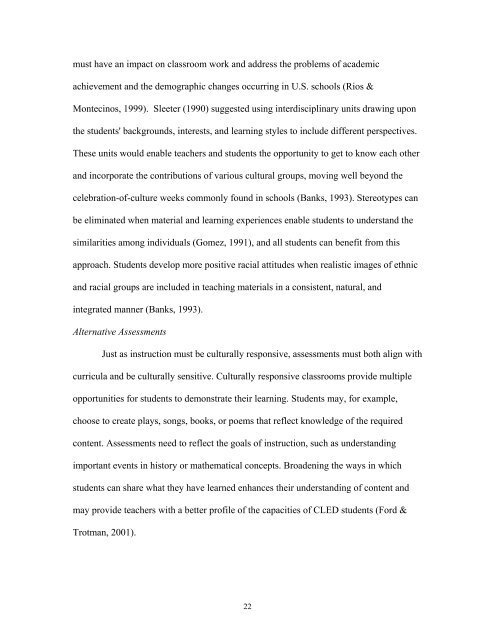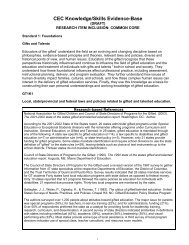Chapter One An Introduction to the Topic of Cultural Diversity - NAGC
Chapter One An Introduction to the Topic of Cultural Diversity - NAGC
Chapter One An Introduction to the Topic of Cultural Diversity - NAGC
Create successful ePaper yourself
Turn your PDF publications into a flip-book with our unique Google optimized e-Paper software.
must have an impact on classroom work and address <strong>the</strong> problems <strong>of</strong> academic<br />
achievement and <strong>the</strong> demographic changes occurring in U.S. schools (Rios &<br />
Montecinos, 1999). Sleeter (1990) suggested using interdisciplinary units drawing upon<br />
<strong>the</strong> students' backgrounds, interests, and learning styles <strong>to</strong> include different perspectives.<br />
These units would enable teachers and students <strong>the</strong> opportunity <strong>to</strong> get <strong>to</strong> know each o<strong>the</strong>r<br />
and incorporate <strong>the</strong> contributions <strong>of</strong> various cultural groups, moving well beyond <strong>the</strong><br />
celebration-<strong>of</strong>-culture weeks commonly found in schools (Banks, 1993). Stereotypes can<br />
be eliminated when material and learning experiences enable students <strong>to</strong> understand <strong>the</strong><br />
similarities among individuals (Gomez, 1991), and all students can benefit from this<br />
approach. Students develop more positive racial attitudes when realistic images <strong>of</strong> ethnic<br />
and racial groups are included in teaching materials in a consistent, natural, and<br />
integrated manner (Banks, 1993).<br />
Alternative Assessments<br />
Just as instruction must be culturally responsive, assessments must both align with<br />
curricula and be culturally sensitive. <strong>Cultural</strong>ly responsive classrooms provide multiple<br />
opportunities for students <strong>to</strong> demonstrate <strong>the</strong>ir learning. Students may, for example,<br />
choose <strong>to</strong> create plays, songs, books, or poems that reflect knowledge <strong>of</strong> <strong>the</strong> required<br />
content. Assessments need <strong>to</strong> reflect <strong>the</strong> goals <strong>of</strong> instruction, such as understanding<br />
important events in his<strong>to</strong>ry or ma<strong>the</strong>matical concepts. Broadening <strong>the</strong> ways in which<br />
students can share what <strong>the</strong>y have learned enhances <strong>the</strong>ir understanding <strong>of</strong> content and<br />
may provide teachers with a better pr<strong>of</strong>ile <strong>of</strong> <strong>the</strong> capacities <strong>of</strong> CLED students (Ford &<br />
Trotman, 2001).<br />
22

















